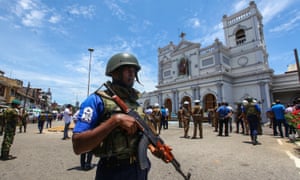Sri Lanka bombings: Islamist group blamed but focus also on failure of security forces
Posted on April 22nd, 2019
Jason Burke Courtesy The Guardian (UK)
National Thowheeth Jama’ath named as perpetrators as focus shifts to warning received at least 10 days before
Mon 22 Apr 2019 12.54 BSTLast modified on Mon 22 Apr 2019 13.22 BST

Sri Lankan officials have blamed a small local group called National Thowheeth Jama’ath for the bomb attacks on Sunday. It is unclear whether this assertion is based on new information discovered by investigators since the atrocity or a notice circulated by Sri Lankan police 10 days before the blasts, which said the group was planning suicide attacks against churches.
There is a similarly named Islamist organisation active on the island nation – the Sri Lanka Thowheeth Jama’ath. It is unclear if this group is the one referred to by the warning, which was based on information passed to Sri Lankan authorities by a foreign intelligence service, believed to be either India’s or the US’s.
The SLTJ is small, based in the east of Sri Lanka, and has been involved in extremist rhetoric as well as being linked to acts of vandalism against Buddhist statues. Its name describes a movement for the unity of God, a favourite label adopted by Islamist militants and a key concept in conservative strands of Islam.
Analysts point out multiple suicide bombings of six or possibly more targets require a significant logistical operation and months of planning. Such attackers may detonate their devices alone, but need careful management by handlers to keep them committed in the days and weeks before. Large quantities of military-grade explosives would also have been necessary, as well as safe houses and bomb-making workshops.
The targets – churches and luxury hotels in high-profile locations – are familiar from many previous attacks by Islamist extremists in south Asia and beyond. Though western attention has been diverted by violence closer to home, the region has had a high level of religiously motivated terrorism for decades. There has also been a surge in Hindu and Buddhist extremism in recent years.
Islamist militant attacks have largely been the work of local groups rather than major international organisations such as Islamic State and al-Qaida, despite the continuing efforts of both to expand in the arc between Afghanistan and Bangladesh. Each group has built links with local factions and individuals, working through what are effectively subcontractors”.
Sometimes the links have been more direct, however. At its peak, Isis successfully attracted a very significant number of recruits from the Maldives, the islands close to Sri Lanka, with which there are strong transport and commercial links.
From descriptions by witnesses, it appears likely the attackers were young local men. This would fit a longstanding rule that almost all terrorist attacks anywhere in the world primarily involve people living near or even brought up close to their targets.
Much of the focus is also now on the failure of the Sri Lankan security agencies. A key factor here is the degree to which different branches and factions within the police, intelligence and military are aligned with various politicians and political parties.
The telecommunications minister, Harin Fernando, gave an unwitting example of how politicised the vision of decision-makers can be. Speaking to BBC Radio 4’s Today programme on Monday, Fernando, who on Sunday night tweeted images of the memo from the Sri Lankan intelligence services dated 11 April, which laid out details of a possible planned attack, said the government also had not ruled out an attempted coup.
There are so many ways we could look at this, but right now our biggest priority would be to find what really led these eight or 10 or 12 men to carry out this attack,” he said. But we are not ruling out a coup as well.”